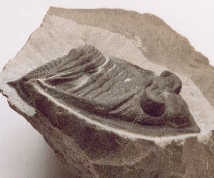|
The Order PHACOPIDA
(Salter, 1864)
At the PHACOPIDA it is about a great variable Order. The size is varying from only a few up to more than 30 cm. All Suborders are connected by a similiar ontogenesis. The PHACOPIDA are including the Suborders Calymenina (Superfamily Calymenoidea), Phacopina (Superfamilies Phacopoidea, Dalmanitoidea and Acastoidea) and the Cheirurina (Superfamily Cheiruroidea). The image shows a representative of the Suborder Phacopina (Superfamily Dalmanitloidea).
|

Odontochile hausmanni
|
|
Epoch Lower Ordovician to Upper Devonian. It's obvious at the imaged Odontochile, the representatives of the Phacopida featuring only a relative small preglabellar field bzw. none. The sutures are normally running, with exception from the representatives of the Calymenia (gonatoparian), proparian. The typically furrowed glabella has up to 4 pair of glabellar furrows. If eyes are present, schizochroal eyes are to be found at the Phacopina, on the other hand, the holochroal type is to be found at the Calymenina and Cheirurina. Except from some representatives of the Phacopina, featuring a impendent hypostome, the remaining representatives featuring the conterminant type. According to this, with the exception of the representatives of Phacopina, a rostral plate is present.
The great thorax has 8 up to 19 segments, sometimes featuring prominent furrows. The rachis is prominent developed, in addition widish at some species.
Regarding size and structures the pygidium varied species-specific. As a rule it is sized smallish relative to the cephalon, though sometimes reaching cranidiums size (Gr.- skull).
|
|